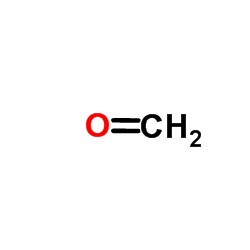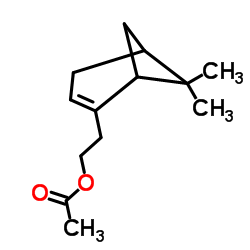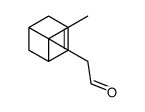128-50-7
| Name | nopol |
|---|---|
| Synonyms |
6,6-dimethyl-2-norpinene-2-ethano
Homomyrtenol 6,6-DIMETHYL-2-NORPINENE-2-ETHANOL EINECS 204-890-3 MFCD00066419 nopyl alcohol 10-HYDROXYMETHYLENE-2-PINENE METHYLOL PINENE Homomyretenol |
| Density | 0.978g/cm3 |
|---|---|
| Boiling Point | 235ºC at 760mmHg |
| Molecular Formula | C11H18O |
| Molecular Weight | 166.26000 |
| Flash Point | 98.9ºC |
| Exact Mass | 166.13600 |
| PSA | 20.23000 |
| LogP | 2.36120 |
| Vapour Pressure | 0.00937mmHg at 25°C |
| Index of Refraction | 1.492-1.494 |
Synonym:6,6-Dimethylbicyclo[3.1.1]hept-2-ene-2-ethanol; Bicyclo 3.1.1hept-2-ene-2-ethanol, 6,6-dimethyl-; 6,6-Dimethyl-2-norphinene-2-ethanol; 2-Norpinene-2-ethanol, 6,6-dimethyl Section 2 - COMPOSITION, INFORMATION ON INGREDIENTS
Risk Phrases: 22 Section 3 - HAZARDS IDENTIFICATION EMERGENCY OVERVIEW
Harmful if swallowed. Potential Health Effects Eye: Causes eye irritation. Skin: Causes moderate skin irritation. Ingestion: May be harmful if swallowed. Causes digestive tract irritation. Inhalation: Causes respiratory tract irritation. Chronic: No information found. Section 4 - FIRST AID MEASURES Eyes: Flush eyes with plenty of water for at least 15 minutes, occasionally lifting the upper and lower eyelids. Get medical aid. Skin: Get medical aid. Flush skin with plenty of water for at least 15 minutes while removing contaminated clothing and shoes. Wash clothing before reuse. Ingestion: If victim is conscious and alert, give 2-4 cupfuls of milk or water. Never give anything by mouth to an unconscious person. Get medical aid immediately. Inhalation: Remove from exposure and move to fresh air immediately. If not breathing, give artificial respiration. If breathing is difficult, give oxygen. Get medical aid. Notes to Physician: Section 5 - FIRE FIGHTING MEASURES General Information: As in any fire, wear a self-contained breathing apparatus in pressure-demand, MSHA/NIOSH (approved or equivalent), and full protective gear. During a fire, irritating and highly toxic gases may be generated by thermal decomposition or combustion. Water may be ineffective. Material is lighter than water and a fire may be spread by the use of water. Vapors may be heavier than air. They can spread along the ground and collect in low or confined areas. Extinguishing Media: Use agent most appropriate to extinguish fire. Use water spray, dry chemical, carbon dioxide, or appropriate foam. Section 6 - ACCIDENTAL RELEASE MEASURES General Information: Use proper personal protective equipment as indicated in Section 8. Spills/Leaks: Clean up spills immediately, observing precautions in the Protective Equipment section. Absorb spill using an absorbent, non-combustible material such as earth, sand, or vermiculite. Do not use combustible materials such as sawdust. Provide ventilation. Section 7 - HANDLING and STORAGE Handling: Wash thoroughly after handling. Remove contaminated clothing and wash before reuse. Use with adequate ventilation. Avoid contact with eyes, skin, and clothing. Do not ingest or inhale. Storage: Keep container closed when not in use. Store in a tightly closed container. Store in a cool, dry, well-ventilated area away from incompatible substances. Section 8 - EXPOSURE CONTROLS, PERSONAL PROTECTION Engineering Controls: Facilities storing or utilizing this material should be equipped with an eyewash facility and a safety shower. Use adequate ventilation to keep airborne concentrations low. Exposure Limits CAS# 128-50-7: Personal Protective Equipment Eyes: Wear appropriate protective eyeglasses or chemical safety goggles as described by OSHA's eye and face protection regulations in 29 CFR 1910.133 or European Standard EN166. Skin: Wear appropriate protective gloves to prevent skin exposure. Clothing: Wear appropriate protective clothing to prevent skin exposure. Respirators: A respiratory protection program that meets OSHA's 29 CFR 1910.134 and ANSI Z88.2 requirements or European Standard EN 149 must be followed whenever workplace conditions warrant respirator use. Section 9 - PHYSICAL AND CHEMICAL PROPERTIES Physical State: Viscous liquid Color: colorless Odor: Not available. pH: Not available. Vapor Pressure: Not available. Viscosity: Not available. Boiling Point: 230.0 - 240.0 deg C @ 760.00m Freezing/Melting Point: Not available. Autoignition Temperature: Not available. Flash Point: 98 deg C ( 208.40 deg F) Explosion Limits, lower: Not available. Explosion Limits, upper: Not available. Decomposition Temperature: Solubility in water: Specific Gravity/Density: .9730g/cm3 Molecular Formula: C11H18O Molecular Weight: 166.26 Section 10 - STABILITY AND REACTIVITY Chemical Stability: Stable under normal temperatures and pressures. Conditions to Avoid: Incompatible materials, strong oxidants. Incompatibilities with Other Materials: Strong oxidizing agents. Hazardous Decomposition Products: Carbon monoxide, carbon dioxide. Hazardous Polymerization: Has not been reported Section 11 - TOXICOLOGICAL INFORMATION RTECS#: CAS# 128-50-7: RC8870000 LD50/LC50: CAS# 128-50-7: Draize test, rabbit, skin: 500 mg/24H Moderate; Oral, rat: LD50 = 890 mg/kg; Skin, rabbit: LD50 = >5 gm/kg. Carcinogenicity: Nopol - Not listed by ACGIH, IARC, or NTP. Other: See actual entry in RTECS for complete information. Section 12 - ECOLOGICAL INFORMATION Section 13 - DISPOSAL CONSIDERATIONS Dispose of in a manner consistent with federal, state, and local regulations. Section 14 - TRANSPORT INFORMATION IATA Not regulated as a hazardous material. IMO Not regulated as a hazardous material. RID/ADR Not regulated as a hazardous material. Section 15 - REGULATORY INFORMATION European/International Regulations European Labeling in Accordance with EC Directives Hazard Symbols: XN Risk Phrases: R 22 Harmful if swallowed. Safety Phrases: S 24/25 Avoid contact with skin and eyes. WGK (Water Danger/Protection) CAS# 128-50-7: No information available. Canada CAS# 128-50-7 is listed on Canada's DSL List. CAS# 128-50-7 is not listed on Canada's Ingredient Disclosure List. US FEDERAL TSCA CAS# 128-50-7 is listed on the TSCA inventory. SECTION 16 - ADDITIONAL INFORMATION N/A |
CHEMICAL IDENTIFICATION
HEALTH HAZARD DATAACUTE TOXICITY DATA
|
| Hazard Codes | Xn: Harmful; |
|---|---|
| Risk Phrases | R22 |
|
~99% 
128-50-7 |
| Literature: Pillai, Unnikrishnan R; Sahle-Demessie, Endalkachew Chemical communications (Cambridge, England), 2004 , # 7 p. 826 - 827 |
|
~% 
128-50-7 |
| Literature: Wang, Xueyan; Wang, Tao; Hua, Weiming; Yue, Yinghong; Gao, Zi Catalysis Communications, 2014 , vol. 43, p. 97 - 101 |
|
~86% 
128-50-7 |
| Literature: Ashcroft, Martyn R.; Bougeard, Peter; Bury, Adrian; Cooksey, Christopher J.; Johnson, Michael D. Journal of Organometallic Chemistry, 1985 , vol. 289, p. 403 - 416 |
|
~% 
128-50-7 |
| Literature: Watanabe,S. Bulletin of the Chemical Society of Japan, 1965 , vol. 38, p. 1231 - 1235 |
| Precursor 2 | |
|---|---|
| DownStream 6 | |





![Bicyclo[3.1.1]hept-2-ene-2-ethanol,6,6-dimethyl-, 2-(4-methylbenzenesulfonate) structure](https://image.chemsrc.com/caspic/305/74892-00-5.png)
![Bicyclo[3.1.1]hept-2-ene,2-ethenyl-6,6- dimethyl structure](https://image.chemsrc.com/caspic/299/473-00-7.png)

![2-(6,6-dimethylbicyclo[3.1.1]hept-2-yl)ethanol structure](https://image.chemsrc.com/caspic/214/4747-61-9.png)
![4-(2-bromoethyl)-6,6-dimethylbicyclo[3.1.1]heptane structure](https://image.chemsrc.com/caspic/167/53207-03-7.png)